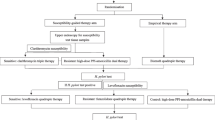Abstract
In order to evaluate the suitability of fosfomycin in combination with other agents for the treatment of Helicobacter pylori infections, the susceptibility profiles of 65 H. pylori strains were determined against multiple antimicrobial agents and combinations thereof using the agar dilution method. For fosfomycin alone, the range of minimum inhibitory concentration (MIC) results and the MICs at which 50% and 90% of strains were inhibited were 0.5–32 μg/ml and 2 and 4 μg/ml, respectively. For the combination of fosfomycin with amoxicillin, clarithromycin or metronidazole, the means calculated for the minimum and maximum fractional inhibitory concentration index were 0.70–1.17 and 1.15–2.03, respectively, suggesting partial synergy or indifference in the majority of strains. The combination of clarithromycin and metronidazole showed synergistic activity against 14 of 28 H. pylori strains tested. The in vitro activity results suggest the combination of fosfomycin with either amoxicillin or clarithromycin may be a promising alternative for the treatment of H. pylori infection. However, the clinical efficacy of these regimens remains to be investigated.
Similar content being viewed by others
References
Megraud F (2001) Resistance of Helicobacter pylori to antibiotics and its impact on treatment options. Drug Resistance Updates 4:178–186
Philipp W, Kofler J (1986) Untersuchung des Penetrationsvermögens von Fosfomycin in das Kammerwasser und den Glaskörper des Auges. Klinische Monatsblätter für Augenheilkunde 189:240–242
Haag R, Hölzlberger R, Rienhoff E, Bartels F, Meissner A (1989) Experimentelle Untersuchungen und Überlegungen zur Verteilung und verzögerten Freisetzung von Fosfomycin aus Knochengewebe. ZAC Zeitschrift für antimikrobielle antineoplastische Chemotherapie 7:3–10
Frossard M, Joukhadar C, Erovic BM, Dittrich P, Mrass PE, van Houte M, et al (2000) Distribution and antimicrobial activity of fosfomycin in the interstitial fluid of human soft tissues. Antimicrob Agents Chemother 44:2728–2732
Drugeon H, Baron D, Chung Courtieu A (1980) The resistance to fosfomycin by mutation. A study in vitro. Clinical consequences. Drugs Exp Clin Res 6:345–349
National Committee for Clinical Laboratory Standards (2000) Methods for dilution antimicrobial susceptibility tests for bacteria that grow aerobically. 5th edn. Approved Standard M7-A5. NCCLS, Villanova, PA, USA
Hirschl AM, Apfalter P, Makristathis A, Rotter M, Wimmer M (2000) In vitro activities of linezolid alone and in combination with amoxicillin, clarithromycin, and metronidazole against Helicobacter pylori. Antimicrob Agents Chemother 44:1977–1979
Moody JA (1991) Synergism testing. Broth microdilution checkerboard and broth macrodilution methods. In: Isenberg HD (ed) Clinical microbiology procedures handbook. Vol. 1. 1. American Society for Microbiology, Washington, D.C., USA. pp.5.18.1–5.18.28
Andrews JM, Baquero F, Beltran JM, Canton E, Crokaert F, Gobernado M, et al (1983) International collaborative study on standardization of bacterial sensitivity to fosfomycin. J Antimicrob Chemother 12:357–361
Gallego A, Rodriguez A, Mata M (1974) Fosfomycin: pharmacological studies. Drugs of Today 10(Suppl 11):161–168
Lind T, Mégraud F, Unge P, et al (1999) The MACH2 study: role of omeprazole in eradication of Helicobacter pylori with 1-week triple therapies. Gastroenterology 116:248–253
Malfertheiner P, Mégraud F, O’Morain C, et al and the European Helicobacter pylori Study Group (2002) Current concepts in the management of Helicobacter pylori infection – The Maastricht 2-2000 Consensus Report. Aliment Pharmacol Ther 16:167–180
Bazzoli F, Pozzato P, Rokkast T (2002) Helicobacter pylori: the challenge in therapy. Helicobacter 7(Suppl1):43–49
Author information
Authors and Affiliations
Corresponding author
Rights and permissions
About this article
Cite this article
Blacky, A., Makristathis, A., Apfalter, P. et al. In vitro activity of fosfomycin alone and in combination with amoxicillin, clarithromycin and metronidazole against Helicobacter pylori compared with combined clarithromycin and metronidazole. Eur J Clin Microbiol Infect Dis 24, 276–279 (2005). https://doi.org/10.1007/s10096-005-1307-9
Published:
Issue Date:
DOI: https://doi.org/10.1007/s10096-005-1307-9




